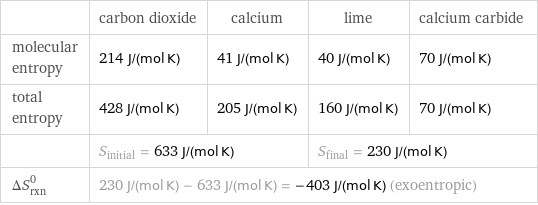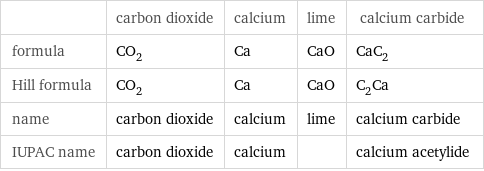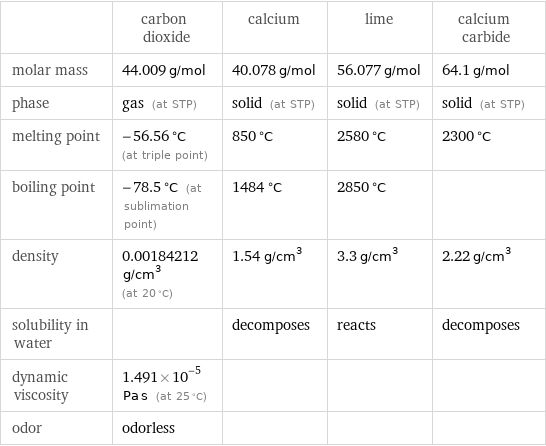Input interpretation

CO_2 carbon dioxide + Ca calcium ⟶ CaO lime + CaC_2 calcium carbide
Balanced equation

Balance the chemical equation algebraically: CO_2 + Ca ⟶ CaO + CaC_2 Add stoichiometric coefficients, c_i, to the reactants and products: c_1 CO_2 + c_2 Ca ⟶ c_3 CaO + c_4 CaC_2 Set the number of atoms in the reactants equal to the number of atoms in the products for C, O and Ca: C: | c_1 = 2 c_4 O: | 2 c_1 = c_3 Ca: | c_2 = c_3 + c_4 Since the coefficients are relative quantities and underdetermined, choose a coefficient to set arbitrarily. To keep the coefficients small, the arbitrary value is ordinarily one. For instance, set c_4 = 1 and solve the system of equations for the remaining coefficients: c_1 = 2 c_2 = 5 c_3 = 4 c_4 = 1 Substitute the coefficients into the chemical reaction to obtain the balanced equation: Answer: | | 2 CO_2 + 5 Ca ⟶ 4 CaO + CaC_2
Structures

+ ⟶ +
Names

carbon dioxide + calcium ⟶ lime + calcium carbide
Reaction thermodynamics
Enthalpy

| carbon dioxide | calcium | lime | calcium carbide molecular enthalpy | -393.5 kJ/mol | 0 kJ/mol | -634.9 kJ/mol | -59.8 kJ/mol total enthalpy | -787 kJ/mol | 0 kJ/mol | -2540 kJ/mol | -59.8 kJ/mol | H_initial = -787 kJ/mol | | H_final = -2599 kJ/mol | ΔH_rxn^0 | -2599 kJ/mol - -787 kJ/mol = -1812 kJ/mol (exothermic) | | |
Entropy

| carbon dioxide | calcium | lime | calcium carbide molecular entropy | 214 J/(mol K) | 41 J/(mol K) | 40 J/(mol K) | 70 J/(mol K) total entropy | 428 J/(mol K) | 205 J/(mol K) | 160 J/(mol K) | 70 J/(mol K) | S_initial = 633 J/(mol K) | | S_final = 230 J/(mol K) | ΔS_rxn^0 | 230 J/(mol K) - 633 J/(mol K) = -403 J/(mol K) (exoentropic) | | |
Equilibrium constant
![Construct the equilibrium constant, K, expression for: CO_2 + Ca ⟶ CaO + CaC_2 Plan: • Balance the chemical equation. • Determine the stoichiometric numbers. • Assemble the activity expression for each chemical species. • Use the activity expressions to build the equilibrium constant expression. Write the balanced chemical equation: 2 CO_2 + 5 Ca ⟶ 4 CaO + CaC_2 Assign stoichiometric numbers, ν_i, using the stoichiometric coefficients, c_i, from the balanced chemical equation in the following manner: ν_i = -c_i for reactants and ν_i = c_i for products: chemical species | c_i | ν_i CO_2 | 2 | -2 Ca | 5 | -5 CaO | 4 | 4 CaC_2 | 1 | 1 Assemble the activity expressions accounting for the state of matter and ν_i: chemical species | c_i | ν_i | activity expression CO_2 | 2 | -2 | ([CO2])^(-2) Ca | 5 | -5 | ([Ca])^(-5) CaO | 4 | 4 | ([CaO])^4 CaC_2 | 1 | 1 | [CaC2] The equilibrium constant symbol in the concentration basis is: K_c Mulitply the activity expressions to arrive at the K_c expression: Answer: | | K_c = ([CO2])^(-2) ([Ca])^(-5) ([CaO])^4 [CaC2] = (([CaO])^4 [CaC2])/(([CO2])^2 ([Ca])^5)](../image_source/ebb90b7bbe22d08c19a0cfe313bed387.png)
Construct the equilibrium constant, K, expression for: CO_2 + Ca ⟶ CaO + CaC_2 Plan: • Balance the chemical equation. • Determine the stoichiometric numbers. • Assemble the activity expression for each chemical species. • Use the activity expressions to build the equilibrium constant expression. Write the balanced chemical equation: 2 CO_2 + 5 Ca ⟶ 4 CaO + CaC_2 Assign stoichiometric numbers, ν_i, using the stoichiometric coefficients, c_i, from the balanced chemical equation in the following manner: ν_i = -c_i for reactants and ν_i = c_i for products: chemical species | c_i | ν_i CO_2 | 2 | -2 Ca | 5 | -5 CaO | 4 | 4 CaC_2 | 1 | 1 Assemble the activity expressions accounting for the state of matter and ν_i: chemical species | c_i | ν_i | activity expression CO_2 | 2 | -2 | ([CO2])^(-2) Ca | 5 | -5 | ([Ca])^(-5) CaO | 4 | 4 | ([CaO])^4 CaC_2 | 1 | 1 | [CaC2] The equilibrium constant symbol in the concentration basis is: K_c Mulitply the activity expressions to arrive at the K_c expression: Answer: | | K_c = ([CO2])^(-2) ([Ca])^(-5) ([CaO])^4 [CaC2] = (([CaO])^4 [CaC2])/(([CO2])^2 ([Ca])^5)
Rate of reaction
![Construct the rate of reaction expression for: CO_2 + Ca ⟶ CaO + CaC_2 Plan: • Balance the chemical equation. • Determine the stoichiometric numbers. • Assemble the rate term for each chemical species. • Write the rate of reaction expression. Write the balanced chemical equation: 2 CO_2 + 5 Ca ⟶ 4 CaO + CaC_2 Assign stoichiometric numbers, ν_i, using the stoichiometric coefficients, c_i, from the balanced chemical equation in the following manner: ν_i = -c_i for reactants and ν_i = c_i for products: chemical species | c_i | ν_i CO_2 | 2 | -2 Ca | 5 | -5 CaO | 4 | 4 CaC_2 | 1 | 1 The rate term for each chemical species, B_i, is 1/ν_i(Δ[B_i])/(Δt) where [B_i] is the amount concentration and t is time: chemical species | c_i | ν_i | rate term CO_2 | 2 | -2 | -1/2 (Δ[CO2])/(Δt) Ca | 5 | -5 | -1/5 (Δ[Ca])/(Δt) CaO | 4 | 4 | 1/4 (Δ[CaO])/(Δt) CaC_2 | 1 | 1 | (Δ[CaC2])/(Δt) (for infinitesimal rate of change, replace Δ with d) Set the rate terms equal to each other to arrive at the rate expression: Answer: | | rate = -1/2 (Δ[CO2])/(Δt) = -1/5 (Δ[Ca])/(Δt) = 1/4 (Δ[CaO])/(Δt) = (Δ[CaC2])/(Δt) (assuming constant volume and no accumulation of intermediates or side products)](../image_source/293b64e22be34e563a5eb5799e79137a.png)
Construct the rate of reaction expression for: CO_2 + Ca ⟶ CaO + CaC_2 Plan: • Balance the chemical equation. • Determine the stoichiometric numbers. • Assemble the rate term for each chemical species. • Write the rate of reaction expression. Write the balanced chemical equation: 2 CO_2 + 5 Ca ⟶ 4 CaO + CaC_2 Assign stoichiometric numbers, ν_i, using the stoichiometric coefficients, c_i, from the balanced chemical equation in the following manner: ν_i = -c_i for reactants and ν_i = c_i for products: chemical species | c_i | ν_i CO_2 | 2 | -2 Ca | 5 | -5 CaO | 4 | 4 CaC_2 | 1 | 1 The rate term for each chemical species, B_i, is 1/ν_i(Δ[B_i])/(Δt) where [B_i] is the amount concentration and t is time: chemical species | c_i | ν_i | rate term CO_2 | 2 | -2 | -1/2 (Δ[CO2])/(Δt) Ca | 5 | -5 | -1/5 (Δ[Ca])/(Δt) CaO | 4 | 4 | 1/4 (Δ[CaO])/(Δt) CaC_2 | 1 | 1 | (Δ[CaC2])/(Δt) (for infinitesimal rate of change, replace Δ with d) Set the rate terms equal to each other to arrive at the rate expression: Answer: | | rate = -1/2 (Δ[CO2])/(Δt) = -1/5 (Δ[Ca])/(Δt) = 1/4 (Δ[CaO])/(Δt) = (Δ[CaC2])/(Δt) (assuming constant volume and no accumulation of intermediates or side products)
Chemical names and formulas

| carbon dioxide | calcium | lime | calcium carbide formula | CO_2 | Ca | CaO | CaC_2 Hill formula | CO_2 | Ca | CaO | C_2Ca name | carbon dioxide | calcium | lime | calcium carbide IUPAC name | carbon dioxide | calcium | | calcium acetylide
Substance properties

| carbon dioxide | calcium | lime | calcium carbide molar mass | 44.009 g/mol | 40.078 g/mol | 56.077 g/mol | 64.1 g/mol phase | gas (at STP) | solid (at STP) | solid (at STP) | solid (at STP) melting point | -56.56 °C (at triple point) | 850 °C | 2580 °C | 2300 °C boiling point | -78.5 °C (at sublimation point) | 1484 °C | 2850 °C | density | 0.00184212 g/cm^3 (at 20 °C) | 1.54 g/cm^3 | 3.3 g/cm^3 | 2.22 g/cm^3 solubility in water | | decomposes | reacts | decomposes dynamic viscosity | 1.491×10^-5 Pa s (at 25 °C) | | | odor | odorless | | |
Units
